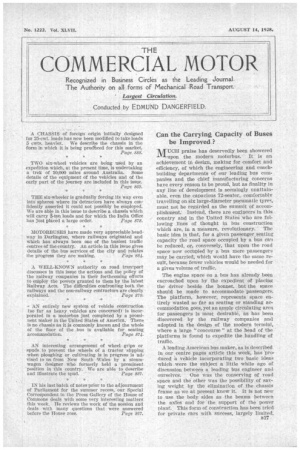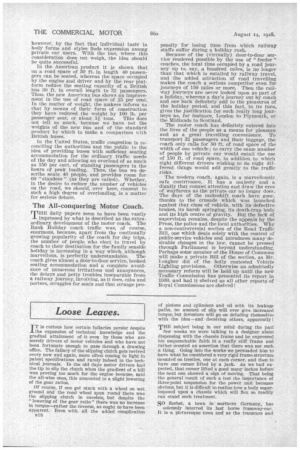Can the Carrying Capacity of Buses be Improved.?
Page 43

Page 44

If you've noticed an error in this article please click here to report it so we can fix it.
MUCH praise has deservedly been showered ---upon the modern motorbus. It is an achievement in design, making for comfort and efficiency, of which the engineering and coachbuilding departments of our leading bus companies and the chief manufacturing concerns have every reason to be proud, but as finality in any line of development is seemingly unattainable, even the capacious 72-seater,. comfortably travelling on six large-diameter pneumatic tyres, must not be regarded as the summit of accomplishment: • Instead, there are engineers in this country and in the United States who are following lines a thought in bus construction which are, in a measure, revolutionary. The basic idea is that, for a given passenger .seating capacity the road space occupied by a bus eau be reduced, or, conversely, that upon the road space now occupied by a bus more passengers may be carried, which would have the same result, because fewer vehicles would be needed for a given volume of traffic.
The engine space on a bus has already been encroached upon by the expedient of placing the driver beside the bonnet, but the space should be made to accommodate 'passengers. The platform, however, represents space entirely wasted so far as seating or standing accommodation goes, yet an ample circulating area for passengers is most desirable, as has been discovered by the railway companies and adopted in the 'design of the modern termini, where a large " concourse " at the head of the platforms is found to expedite the handling of traffic.
A leading American bus maker, as is described in our centre pages article this week, has 'produced a vehicle incorporating two basic ideas which were the subject a little while ago of discussion between a leading bus engineer and ourselves. One was the conserving of road space and the other was the possibility of saving weight by the elimination of the chassis frame as we at present know it. It is not new to use the body sides as the beams between the axles and for .-the support of the power plant. This form of construction has been tried for private cars with success, largely limited',
however, by the fact that individual taste in body forms and styles finds expression among private car users. With the bus, where this consideration does not weigh, the Idea should be quite successful.
In the American product it is shown that on a road space of 30 ft. in length 40 passengers can be seated, whereas the space occupied by the engine and driver and by the rear platform reduce the seating capacity of a British bus 30 ft. in overall length to 32 passengers. Thus, the new American bus shows an improvement in the use of road space of 25 per cent. In the matter of weight, the makers inform us that by means of their form of construction they have reduced the weight by 100 lb. per passenger seat, or about 11 tons. This does not tell us much, because we have not the weights of the new bus and of the standard product by which to make a comparison with British buses.
In the United States, traffic congestion is reconciling the authorities and the public to the idea of providing buses with sufficient seating accommodation for the ordinary traffic needs of the day and allowing an overload of as much as 150 per cent. of standing passengers in the hours of peak loading. Thus, the bus we describe seats 40 people, and provides room for 60 " standees " (as they are called). Whether, in the desire to reduce the number of vehicles on the road, we should, over here, consent to such a high degree of overloading, is a matter for serious debate.
The All-conquering Motor Coach.
THE daily papers seem to have been vastly impressed by what is described as the extraordinary development of the motor coach. The Bank Holiday coach traffic was, of course, enormous, because, apart from the continually growing popularity of the coach for day trips, the number of people who elect to travel by coach to their destination for the family seaside holiday is increasing in a way which, although Marvellous, is perfectly understandable. The coach gives almost a door-to-door service, booked seating accommodation and a complete avoidance of numerous irritations and annoyances, the delays and petty troubles inseparable from a railway journey, involving, as it does, cabs and porters, struggles for seats and that strange pro
pensity for losing time from which railway staffs suffer during a holiday rush.
Because of the (virtually) door-to-door service rendered possible by the use of " feeder " coaches, the total time occupied by a road journey up to, say, a hundred miles, is no longer than that which is entailed by railway travel, and the added attraction of road travelling makes the coach a serious competitor even for journeys of 150 miles or more Then the railway journeys are never looked upon as part of a holiday, whereas a day's journey out by coach and one back definitely add to the pleasures of the holiday period, and this fact, in its turn, gives the justification for such really long journeys as, for instance, London to Plymouth, or the Midlands to Scotland.
The motor coach has definitely entered into the lives of the people as a means for pleasure and as a great travelling convenience. To transport 32 passengers and their luggage, the coach only calls for 30 ft. of road space of the width of one vehicle ; to carry the same number of people by private car would entail the use of 150 ft. of road space, in addition to which eight different drivers wishing to do eight different things would add greatly to the traffic risks.
The modern coach, again, is a marvellously safe contrivance. It has a majesty and a dignity that compel attention and draw the eyes of wayfarers as the private car no longer does. The days of the makeshift coach have gone, thanks to the crusade which was launched against that class of vehicle, with its defective brakes, its harsh springing, its death-trap body and its high centre of gravity. But the lack of supervision remains, despite the appeals by the Press, the police and the local authorities. Why a non-controversial section of the Road Traffic Bill, one which deals solely with the control of public-service vehicles and introduces many desirable changes in the law, cannot be pressed through Parliament is beyond understanding. Perhaps some member of the House of Commons will make a private Bill of the section, as Mr. Lougher did of the hotly contested Vehicle Lighting provisions. Otherwise an admittedly necessary reform will be held up until the new Traffic Commission has presented its report in 1930, and had it shelved as all other reports of Royal Commissions are shelved !




















































































































